|
We will discuss some information already covered, but in a more stepwise and, perhaps, more intuitive way. Why? It is deep and difficult but central to everything. Like E=MC2 to physics, the key to understanding this stuff.
We start with Inman's classic work which described those features of human walking which were essential to it. The underpinning was that these features produced EFFICIENCY.
You hear all the time about how all sorts of animals are better than us, better eyes, better speed, better whatever. Yes, they are very adapted to their place in this world. But we have no place, no specific place.
We are hugely adaptive and energy efficient.
In an unpaved world, a lumpy bumpy place, we get from one place to another with extraordinary conservation of energy... only a wee bit above just sitting there. We recycle. Any momentum used to do one thing gets
steered into the next thing. That requires continuity and a mechanism to preserve momentum - the pendulum.
To get from here to there, our center of mass (the spot where we balance lying on a horizontal see saw). A wheel would be nice, but only if the route were paved and flat, ask anybody in a wheel chair how limiting
wheels are. Our bodies travel nearly a level path as our legs adapt to the surface allowing what approaches a straight line. Approaches, but not perfectly straight. A sine wave is next best to dead straight and the
closer to straight the better.
Each leg creates an arc. So we travel over alternating right and left arcs - hills. The lower the hills the better. But where the hills meet can't be sharply reversing So altitude needs to come off the hills, knee
flexion does that as we ride up and the knee extends on the down side to fill the next valley. The complex foot mechanism does a wonderful job of smoothing that right-left-right sharpness. It is a capacitor.
The muscles do not overtly produce the motions in the ankle-foot mechanism but rather set levels of resistance which have a range to which they can yield within those bounds. It interacts with momentum. Some level of
expectation is required for this to work.
Inman was no air head. He had a real objective. Amputees from war needed prosthetics and just how do you make them? But there is the limitation, as nasty as that sounds, his subjects were intact neurologically and
his tests were on level flat indoor ground.
In context, all valid. But have other needs. Are the mechanisms the same if neurologic injury is added? The assumption of the swing phase mechanics once established nearly eliminated the swing phase events from the
discussion. Inman's criteria become more determinants of stance phase in our context. Can we apply the insights of prosthetics to people with intact anatomy? Let's find out.
A study was performed on healthy volunteers to parallel Inman but not amputees. Simple casts would impair (remove) ankle-foot mechanisms. Would prosthetic rules still apply?
Quick answer. Yes. If the knee and above are intact, no matter how bad you make the foot, if you can wrap the nastiness in prosthetic features, function can go on. We get a gruesome but powerful example from history.
A man (left) with untreated (they didn't know how) club foot could walk well by putting a prosthetic foot under the deformed foot, and wearing a nicely disguised high heel shoe on the other side. A left hip hike
helps offset the length difference this leaves. Trousers covered all this.
Some women with club feet elected to amputate them so as to have nicer looking prosthetics which worked very well as feet. The idea of cybernetics is not new, it's just nowadays requires batteries. This
was pursuit of happiness, not sitting on the sidelines, being in the game of life.
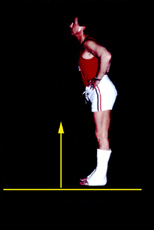 A volunteer wearing two casts that hold his feet in a down pointing posture is
working hard to stand. He either has to balance on his tip toes - very hard - or he would fall over backward, unless he flexes at the hips. This "Jack Knife"
posture seen in CP is relentlessly blamed on truncal weaknes or hip flexors. NOT. Simple balance requirement... center of body mass has to be over center of feet. A volunteer wearing two casts that hold his feet in a down pointing posture is
working hard to stand. He either has to balance on his tip toes - very hard - or he would fall over backward, unless he flexes at the hips. This "Jack Knife"
posture seen in CP is relentlessly blamed on truncal weaknes or hip flexors. NOT. Simple balance requirement... center of body mass has to be over center of feet.
He could not walk this way. Rocker bottom shoes (wheel bottoms which assume a centered axle) failed miserably as the wheel is NOT centered on the
mechanical axis creating a nasty "CAM". No good. And besides that isn't an accepted prosthetic idea. How do you make a prosthetic foot?
Well the ankle isn't at the center of the foot, but at the back. To get mass centered, the shin area has to tilt forward (or the person will Jack Knife as seen here). And that energy
diverting mechanism of landing on the foot needs to be supplied? How. A simple cushion. Ideally the cushion is not compressed at restful stance, but goes to about half height on lending and recoils. It is a
simple matter of picking a cushion that isn't too cushy. Easy.
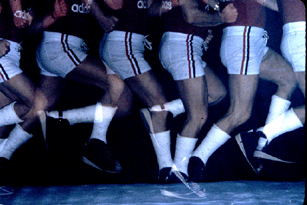 So how do we get this fellow's shins tilted forward?
Wedges. Higher heels. See the shoes? The heels are made high enough to tilt his shins about 5 to 10 degrees forward (it feels right when it is right) and not Jack Knifed. So how do we get this fellow's shins tilted forward?
Wedges. Higher heels. See the shoes? The heels are made high enough to tilt his shins about 5 to 10 degrees forward (it feels right when it is right) and not Jack Knifed.
He can walk easily and he can run. He can run fast and sustain it. He can go home and go to work this way. We have had farmers farm, judo tosser toss, tennis players play and so on. Would you expect less
from a prosthetic? Amputees would have your head if you left them Jacked Knifed. It's about life, pursuing happiness and being in the game.
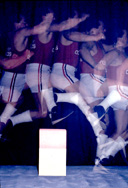 Did we mention hurdles? Yeah, those too. And life's hurdles as well. This is why
women chose to lose their feet to save their existence. Get it right, it works. Did we mention hurdles? Yeah, those too. And life's hurdles as well. This is why
women chose to lose their feet to save their existence. Get it right, it works.
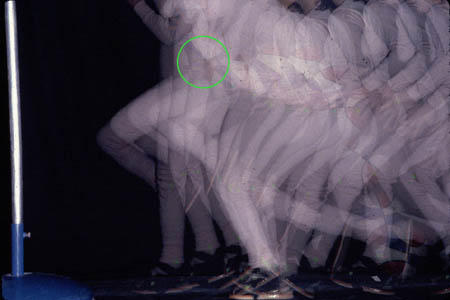
This girl had a problem. A nasty event which wasn't dangerous but painful to both ankles took her out of the game. She was the best player on the team and the basketball championship was
about to go by default. See right, a test of her ability to play - a lay-up shot (ball is red, white, & blue) - net is out of frame. She was
put in a position of comfort. Shoes modified to prosthetic specs, and go practice. She did. They won the game and the championship. She was high scorer. It really GOT to hurt to lose to somebody in two casts!
What does this mean to CP? Alot. If their weakest talent is below the knees, and they have decent skills at the knee and higher, we can supply what is missing with this alone. Duh!!!!!!
<=click Yet, well meaning people keep inflicting impairment on children in the name of free ankle motion. Hinges. How can you walk if you don't have ankle movement? Easily. Ask any amputee. Play them
in basketball and find out.
This youngster has good hip and knee skills, yet the poor ankle-foot control and posture dominates and ruins everything. The back knee is from the backward ankle thrust. It does not need to be there. That knee
abnormality is secondary. It is from the failure to get those feet in better position. The double pendulum action is lost.
The Knee
But does loss of knee motion bode as well? Just a key angle and a cushion? Well we had no studies to tell us what loss of motion did to function. Loss of motion at the ankle meant little if capacitance were
provided by attention to details.
Next study. Stepwise limit the range of motion of the knee by specially rigged devices. Do it two ways. Limit how far the knee can bend. Then the other way, limit how far the knee could extend. This second
one, an imposed crouch would probably look like diplegia - right? And the first one would look like hemiplegia - right? Fast answers are NO and NO. Surprise. Take a look.
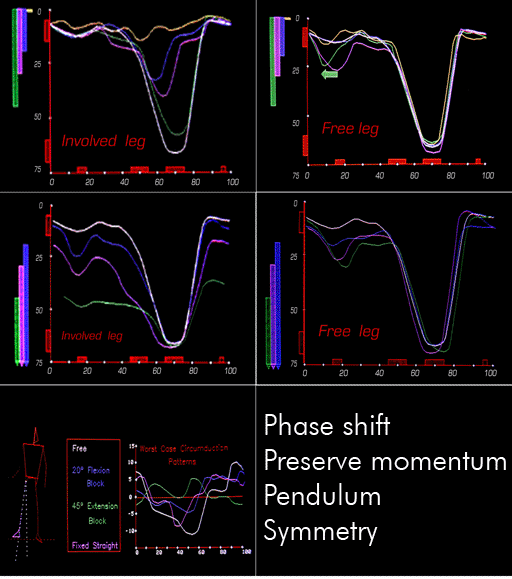 Clearly, stuff was
happening. The subjects all did interesting things to get along with these impairments. Clearly, stuff was
happening. The subjects all did interesting things to get along with these impairments.
We published a tiny part of this series of experiments. We generated a mountain of data. All of it was weird.
These were imposed impairments that we thought might be pushing the line of what you could do to a volunteer.
And yet, you couldn't find a point in all of this, and it was a very long drawn out affair, that the subjects weren't bright and cheerful. "Now, what do you want us to do?"
Merely limiting the range of motion did not rob them of the ability to make do. There were options. We won't trouble you with what phase shift really means, mechanically but think of it like being on a bike and
pumping harder down the hill to get the speed to cruise up the next hill easier. You can bank energy through tricks and do your work ahead. For that to work on a bike the low spot between the hills better
not be mud. The momentum you generate has to be preserved or it is for nothing.
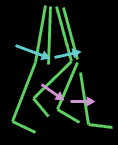 Where is the place to put that energy? The swinging leg is not only a pendulum, but a
linked paired pendulum that allows such energy storage and better, complex and clever retrieval of that energy. But things are happening FAST and the tweaking needed to make this work has to be well timed and fast. Where is the place to put that energy? The swinging leg is not only a pendulum, but a
linked paired pendulum that allows such energy storage and better, complex and clever retrieval of that energy. But things are happening FAST and the tweaking needed to make this work has to be well timed and fast.
For high potential for rehabilitation we are looking for quick response. To modulate change you need to detect the need for change quickly and be able to respond. Detection is sensory.
So why did we publish such a small portion of such a large study? Aside from the detection of phase shift trickery, pendulum importance (not new), and seeking symmetry to make control easier and timing
possible the rest was a failure.
All our subjects were smiling and geared up to do book reports on how they helped mankind as subjects in a study. But look (click on the *
&*) at these two examples which are "extremes" in range of motion impairment, well within the ranges we see in CP.
These subjects don't LOOK impaired. Yes, we can measure it. But, they don't look like cerebral palsy.
That was our target. Big, really big, range of motion impairments just do not resemble CP. Even when losses in range far exceed those of our patients, these volunteers are not nearly as impaired.
Dang. So if reductions in range are taken in stride - so to speak - what does mess you up? It's that pendulum thing. What messes up a pendulum? Anything that dampens its free swing or requires it to go at
a speed it can't go. Normal subjects can adjust speed and finagle the pendulum to find something that works - something that FEELS right.
How about dampening? What if we don't restrict range at all - but - drag on it. Sap the momentum? How about elastics that dampen the forward swing?
WOW! Our first attempts to test this failed- we thought. But did they? Aside from a prelim to test how we going to attach things two spectacular failures followed. Both subjects, healthy fellows in good physical
shape (the second one a regular competing marathon runner) - both couldn't go on. We did not get even past the midpoint of our attempted range of study. We had purse lipped , panting subjects lying on the
floor asking to stop.
In addition, our EMG (electrical sensors of muscle activity) were topped out and could not record. On the second try we had gone from linear to logarithmic in detecting EMG and THAT topped out. No point
going on even if the subjects could. Also they could not make it from one infrared beam to the next to trigger the data dump. The second one had a shorter set up but that was too much as well.
So figure it this way, (click on the *&*)
two hearty athletic men could not walk 12 feet after having an elastic applied such that it retarded leg swing. The elastic was always capable of hip flexion to 90 degrees and full knee extension
(with help). Even a very asymmetric attempt was made when real walking was abandoned. In this the ankles were used to divide the job up into parts.
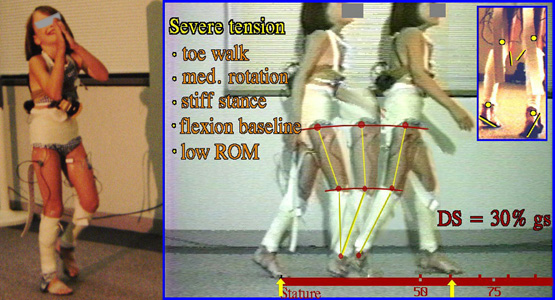 To get EMG required putting our EMG in line with another system with equally large control. So we went to Hershey where our video equipment was used in their lab. To get EMG required putting our EMG in line with another system with equally large control. So we went to Hershey where our video equipment was used in their lab.
Another failed subject was just not to be allowed. So we found a high level competitive Irish step dancer, someone incapable of fatigue. We would dial the EMG down by up to ten thousand fold so as to get
some idea of when things went on and off. That worked. With her aunt yelling "Do it for Ireland!" our subject kept on 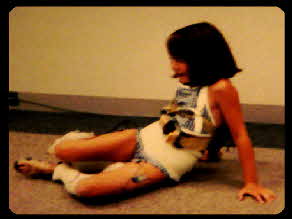 despite occasional pleas for mercy in the form or rests. despite occasional pleas for mercy in the form or rests.
Even so, some respite was needed to go on. And an array of behaviors could not be missed in this and the previous subjects.
There were no restrictions in range across any joint. The ankles were totally free (What you see on the feet are sensors that measure pressure). One elastic strap
was set on each leg running as close as one could get to the medial hamstring. These elastics were always capable of the full range but increased tension in ten
levels which we thought were akin to the clinical range in ambulators (rough guess).
Inward rotation crouch with toe walking was a consistent early adaptation. With mild elastics, the subject merely flexed enough to render the elastic gone then walked "normally" from that flexed baseline.
Once the elastic was inescapable, serious alterations with equally serious fatigue were seen. What followed was not just less of normal motion but a change in the way things worked altogether. In a sense,
without momentum of the pendulum, swing reliant on pendulum for conservation was lost. Gait began to resemble stair climbing. That's what we do when we walk up stairs (and momentum is not there).
But even that failed as tension rose. The last ditch effort to maintain upright (yes subjects resorted to crawling until told not to) gait was using the legs as stiff units. It was a trade off between lessening
tension by flexion and using a little arc as possible against the elastic - staying tangential. So a large wheel is created and centered. A stiff leg from toe to hip is centered by getting the toe exactly below
the high point of the stance arc and a short nearly level small arc step follows. As this stiffened leg moves en bloc, the EMG is high in all muscles. Thus we
see cocontraction -so familiar in CP - in our test subjects. The knee is stiff in stance phase and flexes to swing and even over flexes to relieve tension (for blood flow).
Removal of elastics does NOT allow a final normal walk. All of our subjects were incapable of normalcy until the next day. Lock knee gait similar to muscular dystrophy followed elastic removal - weakness -
from extreme fatigue.
So the gait we see is not from weak anything. Output is Herculean, if anything. It is a product of some ability facing inordinate sapping of energy.
So these subjects looked very much like diplegia. The thing to remember is that they are normal, and athletic and have intact sensory mechanisms.
To the degree that sensibility (not skin, so much) as positional, internal computed possibility is intact we see compensatory behaviors. So, in a sense, as we have good reason to believe these subjects have zero
sensory issues, what we see is not disorder, abnormality as a thing itself, but compensatory behavior given the applied defect.
Think about that. And stop talking about weakness in CP.
RANGE vs GRAB
Range measures how strong and determined the examiner is. Grab measures the walking impediment.
In the anatomy section under THIGH, there is some very interesting stuff about linkages. The whole idea of muscles shortening to make things move may be way off (by what it omits).
SENSORY
When the ability to know is impaired, then severe losses of function follow and - the big AND - and those compensatory mechanisms which exist
are not realized.
Think about a car driven with all the windows painted over. Driving blind. There may be an easy route but
unseen, it goes unused. Many of the very difficult walking disorders are difficult by way of their sensory impairments.
This young lady seems to have nearly no movement skills at all. Just standing there, trying to not fall, but barely able to take a step.
The reality is discovered by giving her
something she can use as a cue, for balance and momentum.. could be nearly anything with wheels to push. Then she looks like any other kid pushing a cart. The motor side gets the
blame. But it works well. She needs feedback.
Click the next image on the right to see.
It was mentioned earlier, that our mechanisms are, in part, set to interact with momentum and yield within that range. We don't control every tiny bit but depend on the mechanisms to
interact with momentum to favor movement and preserve momentum. That requires, as our sensory to brain to muscle electrical transit is chemical and not electrons at speed of light. We need
to anticipate - to expect - anticipate for what we do to work well. As soon as we introduce inconsistency, the determinant of gait I call "anticipation", fails.
As with marbles on the floor, an ankle mechanism that sometimes does this and maybe might do that, freezes us cold. When we go hiking and expectation fails, as the surface is unknown and in random
extremes, we choose to go stable (stiff laced boots) rather than chance injury and balk all other mechanisms to the uncertainty of what our feet might do from step to step. Keep this in mind. Besides, a
good boot looks and acts a whole bunch like a good prosthesis. But we already talked about that.
|